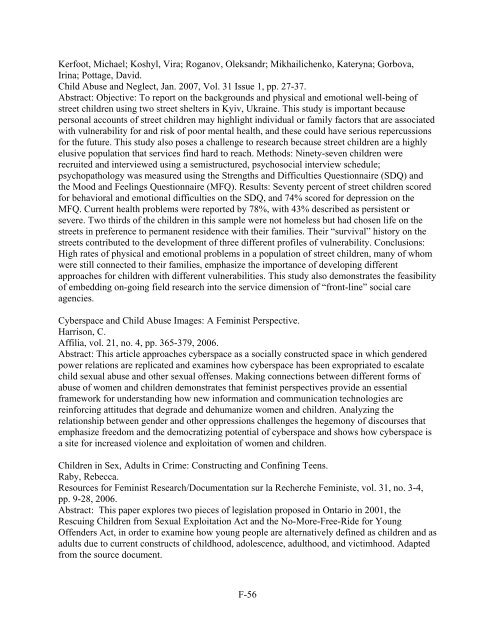The National Strategy for Child Exploitation Prevention and Interdiction
The National Strategy for Child Exploitation Prevention and Interdiction
The National Strategy for Child Exploitation Prevention and Interdiction
Create successful ePaper yourself
Turn your PDF publications into a flip-book with our unique Google optimized e-Paper software.
Kerfoot, Michael; Koshyl, Vira; Roganov, Oleks<strong>and</strong>r; Mikhailichenko, Kateryna; Gorbova, Irina; Pottage, David. <strong>Child</strong> Abuse <strong>and</strong> Neglect, Jan. 2007, Vol. 31 Issue 1, pp. 27-37. Abstract: Objective: To report on the backgrounds <strong>and</strong> physical <strong>and</strong> emotional well-being of street children using two street shelters in Kyiv, Ukraine. This study is important because personal accounts of street children may highlight individual or family factors that are associated with vulnerability <strong>for</strong> <strong>and</strong> risk of poor mental health, <strong>and</strong> these could have serious repercussions <strong>for</strong> the future. This study also poses a challenge to research because street children are a highly elusive population that services find hard to reach. Methods: Ninety-seven children were recruited <strong>and</strong> interviewed using a semistructured, psychosocial interview schedule;psychopathology was measured using the Strengths <strong>and</strong> Difficulties Questionnaire (SDQ) <strong>and</strong> the Mood <strong>and</strong> Feelings Questionnaire (MFQ). Results: Seventy percent of street children scored <strong>for</strong> behavioral <strong>and</strong> emotional difficulties on the SDQ, <strong>and</strong> 74% scored <strong>for</strong> depression on the MFQ. Current health problems were reported by 78%, with 43% described as persistent or severe. Two thirds of the children in this sample were not homeless but had chosen life on the streets in preference to permanent residence with their families. <strong>The</strong>ir “survival” history on the streets contributed to the development of three different profiles of vulnerability. Conclusions: High rates of physical <strong>and</strong> emotional problems in a population of street children, many of whom were still connected to their families, emphasize the importance of developing different approaches <strong>for</strong> children with different vulnerabilities. This study also demonstrates the feasibility of embedding on-going field research into the service dimension of “front-line” social care agencies. Cyberspace <strong>and</strong> <strong>Child</strong> Abuse Images: A Feminist Perspective.Harrison, C. Affilia, vol. 21, no. 4, pp. 365-379, 2006. Abstract: This article approaches cyberspace as a socially constructed space in which gendered power relations are replicated <strong>and</strong> examines how cyberspace has been expropriated to escalate child sexual abuse <strong>and</strong> other sexual offenses. Making connections between different <strong>for</strong>ms of abuse of women <strong>and</strong> children demonstrates that feminist perspectives provide an essential framework <strong>for</strong> underst<strong>and</strong>ing how new in<strong>for</strong>mation <strong>and</strong> communication technologies are rein<strong>for</strong>cing attitudes that degrade <strong>and</strong> dehumanize women <strong>and</strong> children. Analyzing the relationship between gender <strong>and</strong> other oppressions challenges the hegemony of discourses that emphasize freedom <strong>and</strong> the democratizing potential of cyberspace <strong>and</strong> shows how cyberspace is a site <strong>for</strong> increased violence <strong>and</strong> exploitation of women <strong>and</strong> children. <strong>Child</strong>ren in Sex, Adults in Crime: Constructing <strong>and</strong> Confining Teens. Raby, Rebecca. Resources <strong>for</strong> Feminist Research/Documentation sur la Recherche Feministe, vol. 31, no. 3-4, pp. 9-28, 2006. Abstract: This paper explores two pieces of legislation proposed in Ontario in 2001, the Rescuing <strong>Child</strong>ren from Sexual <strong>Exploitation</strong> Act <strong>and</strong> the No-More-Free-Ride <strong>for</strong> Young Offenders Act, in order to examine how young people are alternatively defined as children <strong>and</strong> as adults due to current constructs of childhood, adolescence, adulthood, <strong>and</strong> victimhood. Adapted from the source document. F-56
















